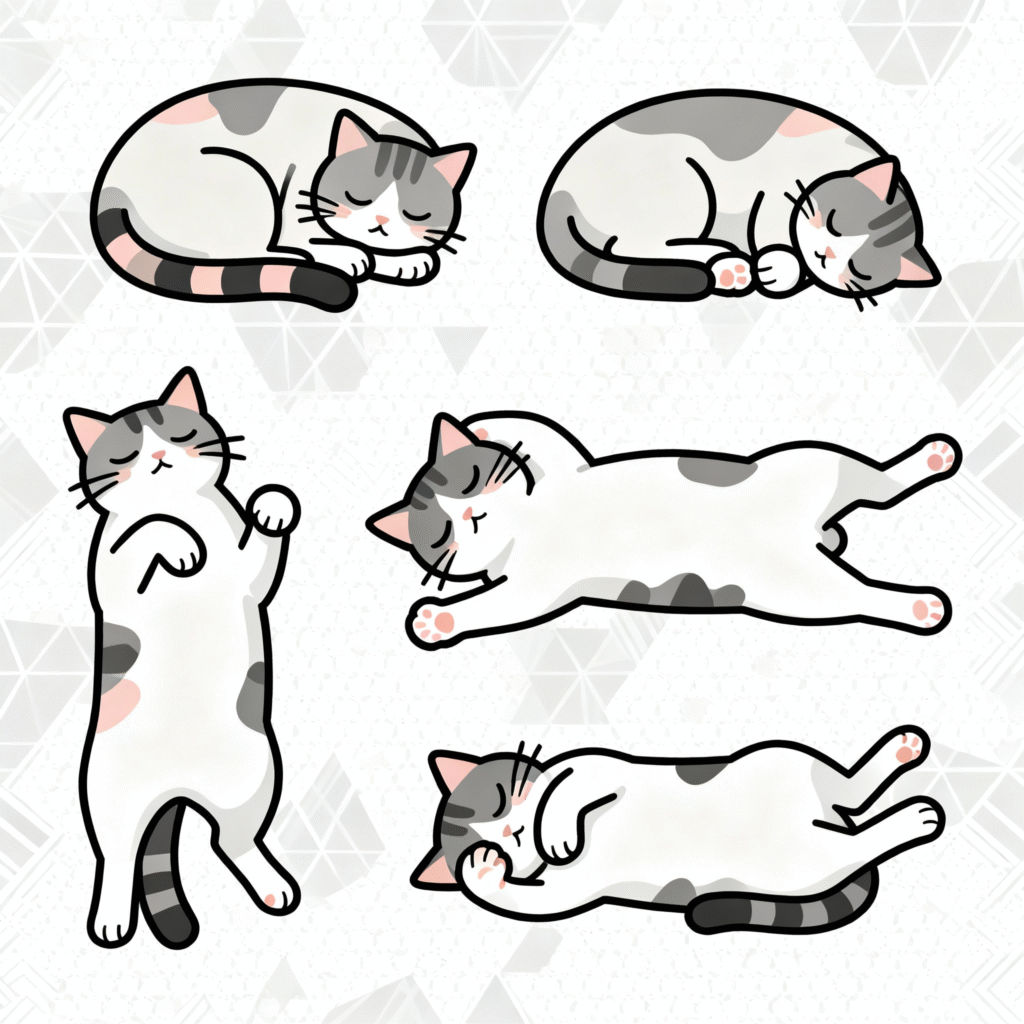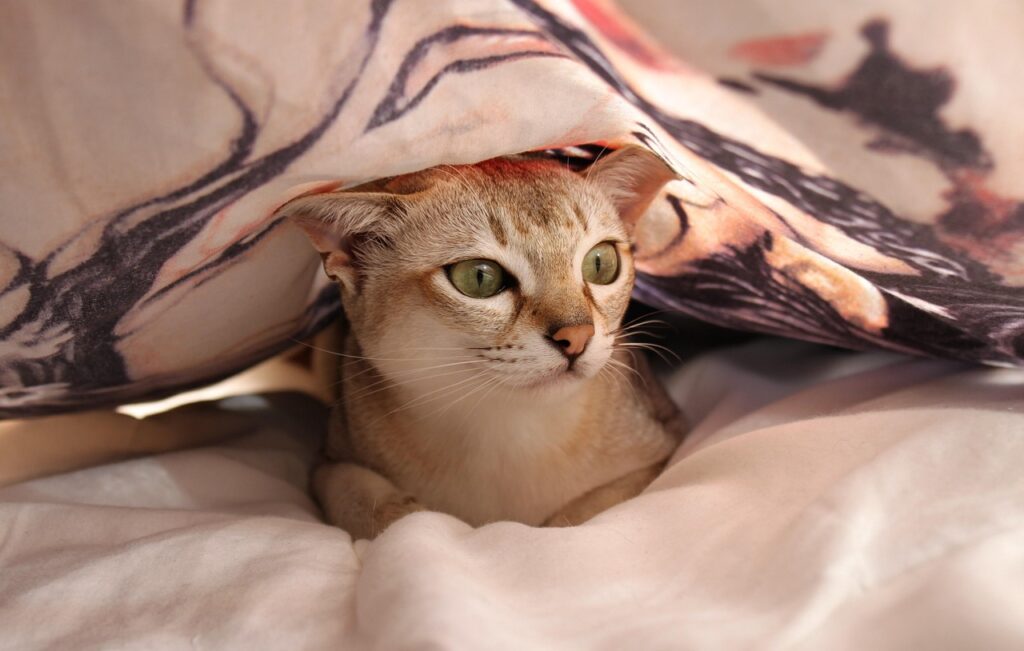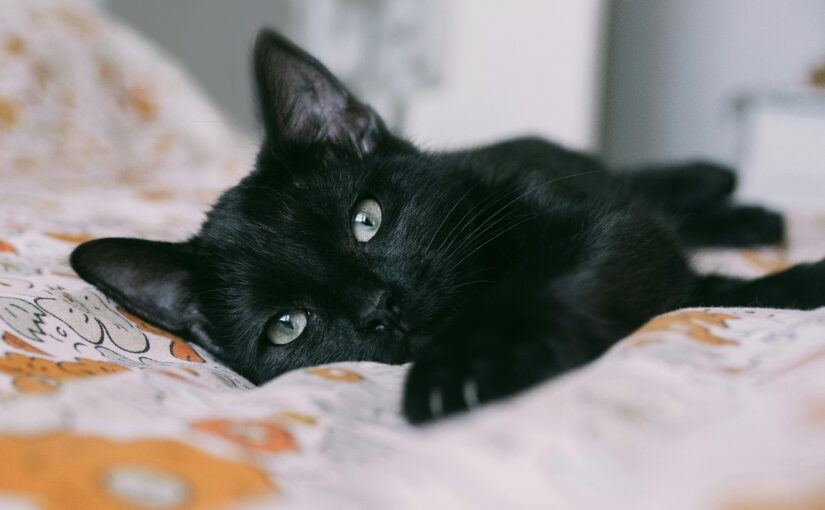The first golden rays of dawn filter through the curtains, casting a soft glow on your bed where your cat lies in serene splendor, a fluffy masterpiece curled like a living pillow against the sheets. Their chest rises and falls in peaceful rhythm, whiskers twitching in dreams of endless chases, embodying pure feline elegance in the quiet morning light. But let’s be real: before this poetic scene unfolds, they’ve already orchestrated their 4 a.m. alarm clock routine, meowing insistently for breakfast until you stumble out of bed. Soon after, they return and reclaim their spot with triumphant indifference, as if the world revolves around their empty bowl.
If you’re a cat owner, you’ve likely experienced this scenario: you settle into bed for the night, and within moments, soft paws pad across the floor. Before you know it, your feline companion has claimed their spot on your mattress, curling up against your legs or nestling into the crook of your arm. This nightly ritual is incredibly common among cat households, yet it raises fascinating questions about feline behavior, trust, and the unique bonds we share with our pets.
Understanding why cats choose to sleep with their humans reveals much about their psychology, their evolutionary history, and the depth of the relationship they form with us. From warmth-seeking instincts to displays of profound trust, the reasons behind this behavior are both practical and deeply emotional.

Why Cats Are Drawn to Human Beds
Cats are notorious nappers, sleeping an average of twelve to sixteen hours each day. Given how much time they spend snoozing, it makes sense that they’re particular about where they rest. Your bed, as it turns out, offers several irresistible qualities that make it the perfect sleeping spot from a feline perspective.
The most obvious attraction is warmth. Cats are heat-seeking creatures by nature, and humans function as excellent living heating pads. When we settle into bed, our body temperature creates a cozy microclimate that appeals to their instinctive desire for comfortable, warm resting spots. This preference is intensified by soft blankets, plush pillows, and the general comfort of human bedding, which mimics the snug environments cats naturally seek out.
Beyond physical comfort, there’s a behavioral component rooted in routine. Cats are creatures of habit who adapt to the rhythms of their household. When you establish a regular bedtime, your cat learns this pattern and adjusts their own schedule accordingly. They anticipate your evening routine and position themselves to be part of it, demonstrating remarkable attunement to human habits.
Perhaps most significantly, sleeping beside you provides your cat with a sense of security and belonging. In the wild, cats are both predators and prey, which means they’re naturally cautious about vulnerability during sleep. When a cat chooses to rest next to you, it’s a powerful statement of trust. They’re communicating that they feel safe enough in your presence to enter their most defenseless state. This behavior should be interpreted as a genuine compliment: your cat views you as a protector and companion worthy of their confidence.

Decoding Common Bedtime Behaviors
Cat owners often notice peculiar behaviors when their feline friends settle in for the night. These actions aren’t random quirks but meaningful communications rooted in instinct and emotion.
Kneading, sometimes called “making biscuits,” is one of the most endearing behaviors cats display in bed. This rhythmic pushing motion with their paws originates from kittenhood, when nursing kittens knead their mother’s belly to stimulate milk flow. Adult cats retain this instinctive behavior because it’s deeply associated with comfort, contentment, and security. When your cat kneads your blankets or even your body before settling down, they’re recreating that primal sense of safety and satisfaction. The behavior also serves a territorial purpose, as cats have scent glands in their paw pads and use kneading to mark their favorite spots.
Another common behavior is digging or burrowing in the bedding before lying down. This harks back to ancestral instincts when wild cats would prepare sleeping areas by clearing away debris or creating comfortable depressions in grass or sand. In your bed, this translates to your cat arranging blankets and pillows into their ideal configuration. It’s their way of personalizing their sleeping space and ensuring maximum comfort.
When your cat cuddles close to you at night, they’re demonstrating affection and seeking the reassurance of your presence. This isn’t just about warmth, it’s about emotional connection. Cats form strong attachments to their favorite humans, and choosing to sleep touching or near you reflects the depth of that bond. They enjoy your company and find your proximity soothing enough to facilitate restful sleep.

The Remarkable Benefits of Bedtime Companionship
Allowing your cat to share your sleeping space offers surprising advantages that extend beyond the simple pleasure of furry companionship. Both you and your feline friend can experience genuine benefits from this arrangement.
For cats, sleeping with you satisfies multiple needs simultaneously. They receive warmth, security, and social bonding all in one convenient location. Cats who sleep with their owners often display reduced anxiety and greater overall contentment. The ritual of bedtime together can become a cornerstone of their emotional wellbeing, providing predictability and reinforcing the strength of your relationship.
Humans benefit remarkably from feline bed partners as well. Research from the University of California by Leslie A. Lyons suggests that the unique frequency of a cat’s purr may have therapeutic effects on human muscle and bone healing. While more research is needed, the vibrational qualities of purring fall within ranges known to promote tissue repair and reduce inflammation.
Beyond potential physical healing, the psychological benefits are well-documented. A cat’s purr creates a soothing ambient sound similar to white noise, which many people find deeply calming. This auditory comfort can help quiet racing thoughts and ease the transition into sleep. The gentle weight and warmth of a cat on the bed also provides tactile comfort that reduces stress hormones and promotes relaxation.
Research from the Minnesota Stroke Institute, led by Dr. Adnan Qureshi, found that cat owners have a lower risk of heart attack compared to non-owners. While this study examined cat ownership broadly rather than bed-sharing specifically, it speaks to the cardiovascular benefits of human-feline bonds. The stress reduction and emotional support that comes from close contact with cats contributes to better heart health over time.
Studies from Oregon State University have revealed that cats form attachment bonds with their humans similar to those between dogs and their owners, and even comparable to parent-child relationships. Sharing sleep space deepens these bonds by creating extended periods of close physical proximity. For cats who may have experienced uncertainty or stress, sleeping with a trusted human can be profoundly reassuring and help them feel more secure in their home environment.

What Sleep Positions Reveal About Your Cat
How your cat positions themselves during sleep offers fascinating insights into their emotional state, comfort level, and feelings toward you. While every cat is an individual with unique preferences, certain positions tend to correlate with specific moods and levels of trust.
When your cat stretches out fully on their belly with all four legs extended, they’re displaying complete comfort and relaxation. This vulnerable position indicates they feel safe in their environment, though they remain ready to spring into action if needed. It reflects a balance between relaxation and alertness that’s characteristic of feline nature.
The crescent or curled position is perhaps the most common cat sleeping posture. Cats tuck their paws underneath their body and curl into a comma shape, often wrapping their tail around themselves. This position serves multiple purposes: it conserves body heat, protects vital organs, and represents an instinctive sleeping posture inherited from wild ancestors. While comfortable, it’s also a position from which cats can wake and move quickly if necessary.
When a cat sleeps on their back with their belly exposed and legs splayed, you’re witnessing the ultimate expression of trust and contentment. The abdomen is a cat’s most vulnerable area, containing vital organs with minimal protective coverage. A cat who sleeps belly-up feels absolutely secure and demonstrates complete confidence in their safety. This position is relatively rare, making it a special compliment when your cat displays it around you.
If your cat touches you with their paw while sleeping, interpret this as a gesture of affection and connection. They may be seeking reassurance through physical contact, or simply expressing their desire to maintain connection with you even while resting. This gentle touch is their way of saying they want you close.
Cats who sleep directly on their human, whether on your lap, chest, or stomach, are making a powerful statement about their attachment to you. They’re choosing your body as their preferred resting place over any other option available to them. This behavior combines their desire for warmth, their need for security, and their affection for you into one cozy package.
When your cat positions themselves near your head while you sleep, they’re choosing a spot that places them at your level, facilitating closer bonding. This area also tends to be warmer due to body heat rising, satisfying their thermal preferences while keeping them near your face and voice.
Cats who settle at the foot of the bed demonstrate trust and affection while maintaining a bit more independence. This position allows them to monitor the room’s entrance, satisfying any protective or vigilant instincts while still remaining close to you. Some behavior experts suggest this placement reflects a cat’s desire to “guard” their human during vulnerable sleeping hours.

Understanding When Consistency Matters
Here’s something crucial that every cat owner needs to understand: cats don’t recognize the concept of “just this once.” When you allow your cat into your bedroom and onto your bed even one time, they interpret this as establishing a permanent rule. In their mind, access granted once means access granted forever. This isn’t stubbornness or manipulation, it’s simply how cats understand boundaries and routine.
This characteristic makes it essential to decide from the beginning whether you want to share your sleeping space with your cat. If you allow bedroom access initially and then try to revoke it later, your cat won’t understand the sudden change in rules. They’ll likely feel confused, rejected, and stressed by the inconsistency. This can strain your relationship and lead to behavioral issues as your cat tries to figure out why they’ve lost a privilege they thought was theirs.
Consistency isn’t about being rigid, it’s about respecting how cats process information and maintain their sense of security. If you decide that bed-sharing works for your household, commit to it. If you prefer to keep your bedroom cat-free, establish that boundary from day one and provide alternative comfortable sleeping spaces in other areas of your home.
Some cat owners find compromise solutions helpful. Placing a cat bed or blanket on top of your comforter gives your cat their own designated spot while protecting your bedding from excess fur. Setting up a cat tree or perch in your bedroom allows your feline to be near you at night without being directly on the bed. These arrangements can satisfy your cat’s desire for proximity while maintaining some boundaries.

Some Cats Take Their Bedtime Routines Very Seriously
Anyone who’s lived with cats knows they can be surprisingly insistent about schedules. Some cats develop such strong bedtime rituals that they actively herd their humans toward bed at the appropriate hour. They may vocalize loudly, pace through the house, or follow you persistently until you comply with the established routine.
This behavior stems from cats’ love of predictability and structure. Once they’ve learned that bedtime happens at a certain hour, they expect this pattern to continue. From their perspective, they’re helping maintain order in their household. Some behaviorists suggest this could even represent a form of care-taking, with the cat ensuring their human follows healthy sleep patterns.
Cats may also observe your pre-bed routine with intense interest, watching as you brush your teeth, change clothes, or lock doors. This isn’t distrust but rather territorial awareness. They want to know what’s happening in their domain and confirm that all rituals are being properly observed. In multi-cat households or homes with outdoor cats who come inside at night, this vigilance takes on added significance as cats ensure everyone is accounted for and safe.
This supervisory behavior reflects cats’ social nature, which often surprises people who still believe cats are solitary creatures. While cats hunt alone, they’re actually quite social animals who form complex relationships and community bonds. In the wild, related cats often sleep together in safe locations, watching over one another. Your domestic cat is extending this instinct to you, treating you as part of their family group.
Making the Right Choice for Your Home
Whether to allow your cat in your bed ultimately depends on your personal circumstances, preferences, and household dynamics. There’s no universally correct answer, only what works best for you and your feline companion.
Consider your sleep quality honestly. Some people find a cat’s presence deeply comforting and sleep better with their pet nearby. Others are light sleepers who wake at every movement or find themselves disturbed by a cat’s nocturnal activity. If you have a particularly energetic cat who treats the bed as a playground during the first hour after you lie down, you might find bedtime more frustrating than restful.
Hygiene considerations also play a role. Cats are fastidious groomers who spend hours maintaining their coats, but they can still transfer fur, dander, and outdoor debris to your bedding. Regular grooming of your cat, frequent washing of bed linens, and keeping your cat’s litter box scrupulously clean can minimize these concerns. If you or a household member has allergies, keeping the bedroom as an allergen-free zone might be necessary for health reasons.
For those with multiple pets, bed logistics can become complicated. Some households successfully accommodate several cats or both cats and dogs on one bed, while others find this arrangement too crowded. Pay attention to whether your pets get along harmoniously at night or whether territorial tensions emerge.
If you choose not to allow bedroom access, provide excellent alternative sleeping options throughout your home. Cats need quiet, comfortable, secure places to rest. Consider locations near radiators or in sunny spots, elevated perches that offer good views, and enclosed beds or boxes where cats can retreat for privacy. Having multiple sleeping options allows your cat to choose based on their mood and the time of day.

The Special Language of Nighttime Trust
At its heart, the question of whether cats should sleep in our beds comes down to relationship and communication. When a cat chooses to spend their most vulnerable hours beside you, they’re speaking a language of trust that transcends species barriers. They’re saying they feel safe with you, that your presence brings them comfort, and that they value the connection you share.
This nightly ritual of shared rest creates a unique intimacy between human and cat. In those quiet hours of darkness, with a warm, purring cat nearby, the stresses of the day often fade. The simple act of sharing sleep space becomes a profound expression of mutual care and companionship.
Whether your cat sleeps draped across your ankles, nestled against your side, or on their own bed nearby, what matters most is that they feel secure and loved in your home. The strongest human-cat bonds are built on respect, consistency, and understanding. When you learn to read your cat’s signals, honor their need for routine, and provide them with comfort and safety, you’re nurturing a relationship that enriches both your lives.
So the next time your cat settles onto your bed with a contented sigh, remember that you’re witnessing something special: a small, independent creature who has chosen you as their person and your shared space as their sanctuary. That’s a compliment worth celebrating, whether it happens on your mattress or in the cozy cat bed you’ve placed just a few feet away.
Teaser photo by Lisa.
If you find joy in these tales of twitching whiskers and gleaming eyes, consider helping keep Whiskerito.com alive and purring. Your donation supports thoughtful research, engaging content, and the warm, wonder-filled community that makes this space what it is.
